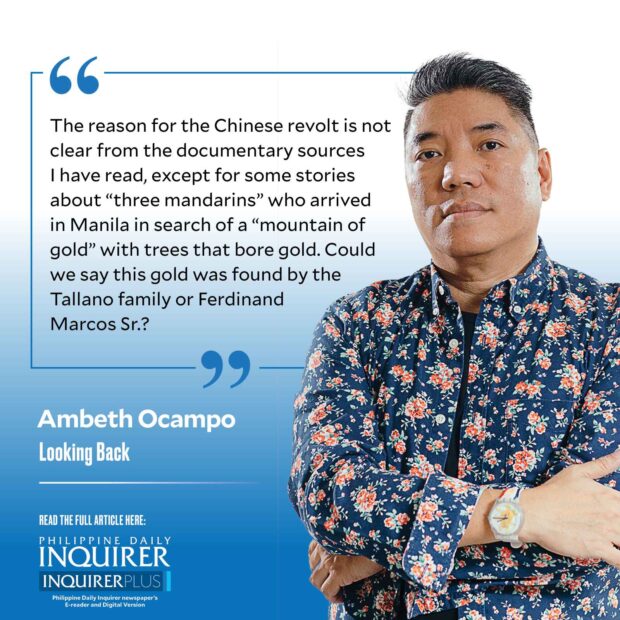Chinese Revolt, 1603
There used to be a group of statues near the old San Ignacio Church grounds in Intramuros that depicted missionaries in their distinctive religious habits. It is unfortunate that being made of resin, these could not withstand the elements, more so the vandals that cut off their hands and feet. Had these been made of bronze or sturdier material, the grouping would educate visitors on the arrival of the different religious orders in the Spanish Philippines.
First were the Augustinians who came with Miguel López de Legazpi in 1565. They had a head start because the navigator of the Legazpi expedition, an Augustinian friar named Andrés de Urdaneta, is memorialized in the city of Urdaneta, Pangasinan, and upscale Urdaneta Village in Makati. Second to reach our shores were the Franciscans in 1578, the Jesuits in 1581, the Dominicans in 1587, and the Recollects in 1606.
Article continues after this advertisementThere are enough printed documentary sources to produce endless columns on each religious order and their work in the Philippines. Just recently, I downloaded 10 volumes of the Jesuit letters or reports from the Philippines beginning from the 16th century for future reference. Also unread on my shelves lie the magisterial history of the Augustinians in the Philippines by my friend and mentor, the late Isacio R. Rodriguez, OSA, an ongoing series that is presently in Volume 22 and hasn’t reached the 20th century yet.
San Francisco de Asís (St. Francis of Assisi), the founder of the Franciscans, is best remembered today as the patron saint of animals and birds. In art, he is sometimes depicted with birds or a wolf. One of my fond childhood memories was bringing my pet dog to church on his feast, Oct. 4, for a special blessing. I was surprised, when reading about the 17th-century Philippines, that St. Francis was considered “the seraphic protector of Manila.” That during the Chinese Revolt of 1603, he was seen on the walls of Intramuros with a flaming sword, driving away the rebels. In another eyewitness account by Miguel Rodriguez Maldonado, the Chinese were repelled by an image hanging over the Parian Gate: “A crucified Christ dripping blood, and at His feet, the seraphic father, St. Francis, with face uplifted toward him. On this account, they became so faint-hearted that they were forced to retire, without being observed from the city, as it was night.”
The deadly Chinese Revolt of 1603 broke out on Oct. 3, the eve of the feast of St. Francis, headed by the Christian Chinese Juan Bautista de Vera, also known by his Chinese name “Eng-Kang.” They overran Spanish defenses, including that in Binondo led by former governor general Luis Dasmariñas and Captain Tomas Bravo de Acuña, who put up a valiant but vain fight. According to the account: “They cut all the Spaniards to pieces, only four of whom escaped, badly wounded and these carried the news to Manila … Next day, Oct. 5, the Sangleys sent the heads of Don Luis, Don Tomas, Joan de Alcega, and other captains to Parián.”
Article continues after this advertisementIt is uncanny that in 1593, Luis’ father, governor general Gómez Pérez Dasmariñas, forced 250 Chinese to row for an expedition against the Moluccas. The Chinese rowers mutinied, killed Dasmariñas, and took over his flagship. Captain Tomas Bravo de Acuña was the nephew of the incumbent governor general Pedro Bravo de Acuña who ordered the fortification and reinforcements of the gates fronting Dilao and Parian where the rebels could enter. Unable to take Intramuros, the Chinese spread out to the suburbs, burning Quiapo and Tondo.
To cut a long story short, Eng-Kang, the leader of the revolt, was hanged on Oct. 11, 1603, and his head was displayed in the Parian. On Oct. 15, two of Eng-Kang’s accomplices, Christian Chinese Miguel Onte and Alonso Sagoyo, were also hanged. Spanish Manila was saved by a combined force of Filipinos and Japanese. Of the loyal natives he singled out, in a report to the King in December 1603, those from: “Pampanga, Bulusan, La Laguna de Bay, Tondo, Bombon, and Calilaya. These are more reasonable people, and more prosperous and civilized than the other Indians, because they are nearer the city of Manila, and show more affection to the Spaniards, and likewise, because they have more courage and spirit.”
The reason for the Chinese revolt is not clear from the documentary sources I have read, except for some stories about “three mandarins” who arrived in Manila in search of a “mountain of gold” with trees that bore gold. Could we say this gold was found by the Tallano family or Ferdinand Marcos Sr.? Estimates of Chinese casualties vary from a low of 15,000 to a high of 30,000 dead. Yet after 1603, the Chinese continued to come to the Philippines and settle like nothing happened. Business as usual. Descendants of these lowly oppressed Chinese, 420 years later, have risen to dominate today’s listing of the richest in the Philippines and threaten our ownership and control of territory in the West Philippine Sea.
—————–
Comments are welcome at aocampo@ateneo.edu

















